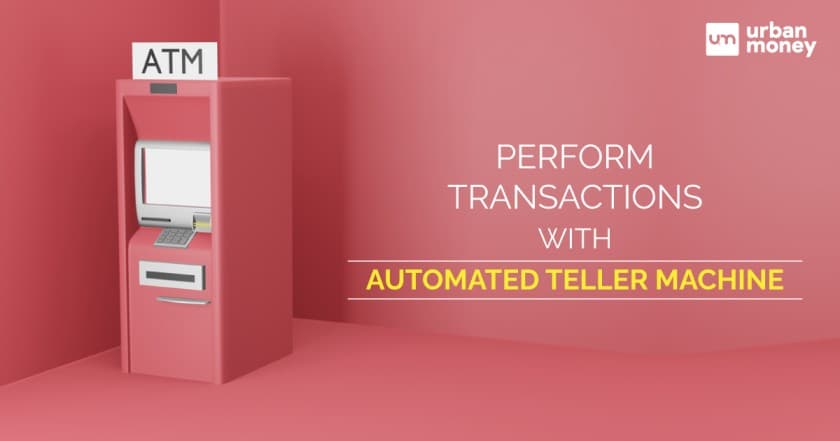ATM Machine - Digitalising Cash Transactions

- Personalized solutions
- Expert guidance
- Application assistance
- Credit score discussion
- Interest rate comparison


Last Updated: 20 December 2025
An electronic device used for financial transactions is known as an Automated Teller Machine or an ATM machine. As the name suggests, it is an automated banking platform that does not need a human teller or a banking agent. John Adrian Shepherd-Barron, Do Duc Cuong and Donald Wetzel invented the first ATM. It is becoming an increasingly common banking option for checking account balances, depositing checks, and withdrawing cash.
Let’s enter the PIN and proceed with the blog covering the Indian ATM machine and its types, functions, advantages and devices while also talking about the first ATM machine in India.
What is an Automated Teller Machine?
The full form of ATM machine is Automated Teller Machine and is set up by various banks and other financial institutions to make daily banking activities easy. An ATM machine is a self-service outlet that allows customers to manage cash and account by inserting their card. Customers can withdraw, deposit or transfer money, see their mini statement, check their balance, update or change their Personal Identification Number (PIN), etc. The first few transactions of the month are free, after which the bank charges a nominal fee on each transaction.
The ATM machine can be better defined as an electronic outlet of a bank that allows a bank to conveniently carry out basic transactions, even in the absence of a bank representative. This machine promises convenience and accessibility.
Types of ATMs
A customer must understand the types of ATMs before visiting one. This knowledge might save them both the time and the cost of travelling to the nearest ATM. An ATM machine is basically of two types.
Basic ATM Machine
A basic machine allows the user to only carry on with services like withdrawing cash and receiving receipts with their most recent account balance. A customer can simply swipe their card in the ATM swipe machine to gain a few useful information.
Advanced ATM Machine
Advanced units are more complex and enable operations such as cash deposits, one-line credit payment facilitation, and account information access. A user needs to have an account with the bank that runs the ATM in order to take advantage of all the services an advanced ATM unit offers.
ATM Labels
The ATM deposit machine can be categorised into a few labels. These labels distinguish the different uses of an ATM.
- Green Label ATMs are used for agricultural purposes.
- Yellow Label ATMs are used for e-commerce transactions.
- Orange Label ATMs are used for share transactions.
- Pink Label ATMs are designed for females to help them eliminate the long queues and waiting time.
- As introduced by the TATA group, White Label ATMs are owned by non-bank entities, not a particular bank.
- Brown Label Banks are operated by a third party other than a bank.
Advantages of ATMs
The users of an Indian ATM machine indulge in the savoury benefits mentioned below.
Convenience
ATMs are installed to provide their customers with the convenience of making financial transactions at a convenient location. The owner of a bank account has the freedom to choose when and where to use a variety of financial services, even outside of regular banking hours. ATMs are now present at all significant locations, making it easier for clients to withdraw or deposit money as needed. This also eliminates the requirement of travelling to the nearest bank branch.
24×7 Service
There is no set operating schedule for ATMs; they are accessible by the users as and when the need arises. Customers, therefore, always have 24×7 access to their bank accounts and can avail of an ATM machine’s service whenever it is convenient for them or in case of an emergency.
Takes the Edge Off the Bank
Customers can access some banking services through ATMs, saving time by avoiding the need to visit the bank. The burden at banks has significantly decreased as a result of people using ATMs to access financial services without going into a bank. Customers are not required to visit the bank for services like cash withdrawals, deposits, or balance enquiries. As a result, ATMs have become a useful tool for easing the workload on banks and enhancing operational flexibility.
Accessibility
Customers can use ATMs to access their accounts anywhere in the nation or abroad. Many significant locations have ATMs installed, so individuals can use them while travelling. Customers can effortlessly withdraw money without carrying a lot of cash.
Saviour in Crisis
In emergency situations, ATMs are crucial. The benefit of ATMs is that they continue to function even when banks close as a result of natural catastrophes, medical emergencies, or economic downturns. In the past, periods of crisis have seen a rise in demand for hard currency. This urgency tugs at a customer’s sense of safety to hold their money in their hands. Automated Teller Machines are essential in both uncertain and regular times, as evidenced by the fact that they can be relied upon in an emergency.
Functions of ATM
The Indian ATM machines were set up to allow their customers to carry forward with the following functions other than simply depositing or withdrawing cash.
Open Fixed Deposit
You can use an ATM machine to open a fixed deposit with your bank. On the ATM’s menu, pick “Open Fixed Deposit,” then enter the required information and choose the term and amount.
Mobile Recharge
Most cellphone providers’ prepaid services allow for ATM recharge. A customer must choose the ‘Mobile Recharge’ option and enter their mobile number, confirm it, and then enter the amount of the recharge. The same method can be used to recharge friends’ and family members’ mobile phones.
Income Tax Payment
Some banks make it simple to pay income taxes using ATMs. This comprises tax paid in advance, tax assessed on one’s own behalf, and tax owed following routine assessment. To avail of this service, a customer must first register the same on the bank’s website or in a branch. An exclusive number will be generated by the ATM once the money has been taken out of your account. After 24 hours, you can use the CIN to access the bank website and print the challan.
Payment of Insurance Premium
A number of insurers, including LIC, HDFC Life, and SBI Life, have partnered with banks to make it easier to pay premiums through ATMs. Simply have the policy number on hand.
Enter the insurer, policy number, and date of birth or mobile number in the “Bill Pay” section, followed by the premium amount and a confirmation.
Other Functions
- An ATM deposit machine can be utilised to deposit cash up to INR 49,900 per transaction. The machine accepts cash denominations of INR 200, INR 500 and INR 1,000.
- If a customer cannot access Netbanking, they can use an Indian ATM machine to transfer money from one bank account to another. The beneficiary account must be registered either online or at a bank branch. There is no cap on the number of transfers allowed each day to the recipient account. However, the amount allowed is up to INR 40,000.
- Apply for personal loans.
- Withdraw cash
- Book railway tickets
- Update or change PIN
- Get account summary
- Check balance
ATMs Input Devices
A customer must understand the basic devices used in assembling an ATM machine. Where each ATM can be developed differently, the basic elements remain the same. The input devices included in ATMs are explained below.
Card Reader
There is a slot for the debit or ATM card to be inserted in every automated teller machine. The account information is often stored on the ATM card’s magnetic strip on the back and occasionally on a chip on the front. These specifics are recognised by the card reader, who then sends them to the user server.
Keypad
The keypad on every ATM allows a customer to enter numbers, clear them, and cancel transactions. It allows you to input both the PIN and the withdrawal amount. These keypads can be virtual keypads on the touchscreen or actual buttons on the ATM.
ATMs Output Devices
The devices that assist a user by displaying their desired results are explained below.
Display Panel
Every ATM has a display panel, typically an LCD or CRT, that shows transaction details, such as how to complete the transaction or the balance remaining after a withdrawal. As a result, it serves as a manual for carrying out a transaction. It offers alternatives for quick cash withdrawals, PIN changing, balance checks, etc.
Cash Dispenser
Bank employees safely load cash into the ATM. A customer can retrieve cash from a cash dispenser once they withdraw a particular amount from the ATM.
Receipt Printer
The ATM’s receipt printer logs the kind of transaction, the amount withdrawn, and the remaining balance after a transaction is complete. In the course of a transaction, ATMs typically ask users if they want a receipt or not. Consequently, they obtain the receipt from the receipt printer upon request.
Speaker
Most ATMs have a speaker that plays audio instructions on how to use the device and conduct transactions. As a result, it also makes it possible for users to conduct transactions easily, even if they are not well-versed with the machine.
How to Use an ATM
A customer needs a bank account and an ATM card linked to that account in order to use the ATM service. Banks typically issue debit cards that can be used for card swipe payments as well as ATM withdrawals and internet payment gateways. The ATM swipe machine makes it possible for a user to swipe their card.
ATM Fees
Customers are now only allowed three free ATM withdrawals each month instead of five, as per a change in Reserve Bank of India (RBI) regulations. Customers in Bengaluru, Mumbai, Chennai, Kolkata, Delhi, and Hyderabad are subject to the rule. It must be kept in mind that at automated teller machines, transactions can be both financial and non-financial. The most that can be taken from each transaction is INR 21.
- Citi Bank continues to provide limitless free transactions.
- IDBI Bank provides five free transactions at other ATMs in addition to free unlimited transactions at its own ATMs.
The table below lists the ATM fees of a few banks.
| Bank | Paid Transactions Amount |
| State Bank of India |
|
| HDFC Bank |
|
| ICICI Bank |
|
| Axis Bank |
|
| Punjab National Bank |
|
Note: The rates provided are true for December 2022.
Using ATMs Abroad
Travellers may easily access their current or savings accounts practically anywhere in the world, thanks to ATMs. You may use an ATM card in a foreign nation if your card association is Visa, MasterCard, or Plus. Depending on the exchange rate on that particular day, the amount debited will be in Indian rupees, and there can be a foreign transaction fee.
However, the bank of the account holder may levy a transaction fee or a percentage of the swapped value. It is difficult to keep track of spending because the currency rate is typically not listed on the receipt from ATMs.
How Much can you Withdraw from an Automated Teller Machine (ATM)?
There are no set business hours for the ATM. It was designed to do so continuously throughout the year, and using this option enables you to do just that. When dispensing cash to individuals, ATMs must conform to certain restrictions. These restrictions only apply to banks and the various types of accounts they provide.
For instance, one bank might have a daily maximum cash withdrawal restriction of INR. 25000 for its most basic account type, while another bank might have a daily maximum limit of INR 40000 for its basic account. Again, the type of account will determine how much a customer can withdraw from the ATM.
How do you make a deposit at an ATM?
The customer must adhere to the following steps to make a deposit at an ATM.
- Visit the nearest ATM
- Insert your debit card and enter the correct PIN to gain access to the registered account
- Opt for the ‘deposit’ option after choosing the type of account
- Enter the amount to be deposited
- Safely place the bills in the cash dispenser slot. The machine will count the amount and display the same on the screen
- If the amount displayed is correct, click on the ‘continue’ option
- The ATM machine will follow the instruction and print a receipt upon a successful deposit
Which bank installed the first ATM in India?
The first ATM machine in India was installed by HSBC in Mumbai in 1987. During the course of the next 10 years, roughly 1500 ATMs were installed in India. The first shared ATM network in India, called Swadhan, was established in 1997 by the Indian Banks’ Association (IBA). For five years, it was run by India Switch Company (ISC), and cardholders could use any ATM in the network to withdraw money for a fee if they did not have an account with the bank that controlled the ATM.
The Bottom Line
It is clear that ATMs have increased people’s accessibility and convenience. Having cash on hand at times of dire need is beneficial. It is especially helpful when banks are closed or when you are not at the location of the bank branch where you have an account. Because you are not dependent on them, you may withdraw money at any time, including on holidays and after business hours.
Frequently Asked Questions (FAQs)
What does ATM mean?
The Automated Teller Machine (ATM) allows a customer to withdraw or deposit money and perform other banking activities like finding out account details, checking balance, changing PIN etc. The customer is required to put in their card to avail of these services.
What is the full name of the ATM?
The full name of the ATM is Automated Teller Machine.
Is ATM an acronym or an abbreviation?
ATM is an acronym for Automated Teller Machine.
What are the main functions of ATMs?
A few of the main functions of ATMs are – depositing, withdrawing or transferring cash, getting details of an account, mini statement, checking balance, updating PIN and paying bills. To understand all the features of an ATM machine, kindly read our blog above.
What are the types of ATMs?
ATMs have different labels assigned to them. A green-labelled ATM is used for agricultural purposes, a yellow-labelled ATM for e-commerce transactions, an orange-labelled for share transactions, and a pink-labelled ATM for women users only. A non-bank third party operates the brown-labelled ATM, and the TATA Group introduced the white-labelled ATM.
How do ATMs make money?
The bank’s representative loads cash in the ATM every day. A bank under the RBI guidelines provides five free transactions, after which a fee is charged on each transaction. To know more on the same, kindly go through our blog above.
Can ATM make mistakes?
Yes, ATMs can make mistakes. These mistakes can include depositing money in a different account, distributing too much or too little cash, not allowing a customer to take back their card, and not providing them with a receipt, etc.
